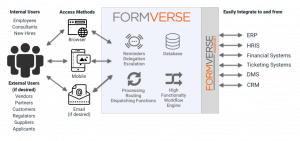Arthur Gniazdowski, CTO of FORMVERSE
Bob Ivkovic, Principal of IT Architects
February 13, 2019
Workflows are all about connecting work, or should I say that they link work tasks together so that people can complete an end-to-end process as a unified team. However, it’s always been a matter of getting people to agree on and define a standard business process that spans cross-functional boundaries. And let’s face it, people have a hard time working with those on the other side of their respective functional areas. Not only do people find it difficult to agree on a cohesive workflow design, but workflow capabilities have been less sophisticated from a technology perspective in the past, until now. It’s these sophisticated workflow capabilities that take the “work” out of workflow. So, you ask what are these sophisticated workflow capabilities? That’s what we’re here to answer.
Enterprise-Wide Workflow Platforms
Some of the more mature enterprise workflow automation platforms allow both internal and external users to interact with its workflow applications using any browser on any device. Users can also access these applications directly from within their email for convenience. No matter how users choose to interact with applications, all data, metadata, and attachments are automatically stored in the workflow database. Once there, application data can be integrated bi-directionally into and out of the customer’s other enterprise applications, such as ERPs, CRMs, HRIS, Financial and Audit Systems, Content & Document Management Systems, Ticketing Systems, and many others. FORMVERSE is one of the new leading-edge workflow platforms that provides such sophisticated workflow capabilities, including real-time reporting using both the FORMVERSE Web App and the existing email platform (Outlook, O365, Gmail/Gsuites etc.) to manage forms across the workflow landscape. Data from various forms can be integrated with other applications and enterprise databases. Thus, FORMVERSE leverages the existing Microsoft infrastructure that is in place, and seamlessly integrates Microsoft Outlook and O365. It can also be configured to enable external users (vendors, suppliers, partners, customers, prospective customers, regulators, etc) to interact with its internal applications as illustrated below. Automation of Business Processes
Automation of Business Processes
These sophisticated workflow platforms allow companies to automate any business process in any functional area for any type of user. Thus, organizations can now easily create highly-functional applications that automate nearly any business process. These applications can be:
- Initiated by internal users and routed to other internal users
- Started internally and be routed externally to users such as vendors, customers, prospective customers, newly-hired staff, suppliers, partners, regulators, etc.
- Initiated by external users and routed internally based upon organizational specifications and requirements
- Accessed directly through a workflow with no routing — internal or external user data entry
An organization can create applications with simple or complex workflow routing rules using a true “drag-and-drop” interface. Furthermore, the organization’s applications can utilize very complex rules without the need to write code using easy-to-use “rule wizards”. These are yet other warrants that take the “work” out of workflow.
Other Sophisticated Workflow Capabilities
We’re here to talk about taking the “work” out of workflow. If we haven’t done that already, here are some key sophisticated workflow capabilities offered in the workflow marketplace today.
1. Bi-directional integration of data to and from other enterprise systems. Sophisticated workflow platforms provide the mechanism to securely collect data by both internal staff and external users. This data can then be extracted based on defined processing rules and integrated with other enterprise applications and databases.
2. Workflow support for multiple devices. Users expect to access workflow applications using a browser on a PC, Mac or mobile device (smartphone or tablet). Applications are initiated using any connected smart mobile device. It doesn’t matter which interface is used, all data, metadata, and attachments are automatically stored in the workflow database for reporting and integration with other systems.
3. Single UI to an enterprise application. Users should have the ability to bi-directionally integrate data between the workflow application and any other core Enterprise Applications (CRM’s, ERP’s, HRIS, Financial Reporting systems, Document & Content Management systems, Ticketing Systems, and many more). This enables the workflow application to be configured and made available to both internal and external users, which can than act as a single user interface to any enterprise system or database.
4. Secure Real-time Reporting. Workflow application data is automatically stored in its own database where authorized users can access reporting dashboards and easily generate reports. These easily customizable reports can include any and all data, metadata, and attachments collected during the workflow. Since every interaction is automatically recorded in the database, workflow reporting can act as an important access point for both internal and external audit purposes.
On-Premise vs Subscription
Some workflow vendors such as FORMVERSE provide subscription pricing based on the number of applications implemented, not the number of users. Whether you have 50 or 500,000 users (internal or external), there is no per-seat license. This licensing structure allows customers to create applications for a single department or for a global workforce. This unique approach to pricing enables customers to prototype a project within a single department prior to launching a full-scale enterprise deployment. And of course, if you feel the subscription model isn’t for you, you’re always free to pay for the software and maintenance based on the on-premise model. These workflow platforms can be implemented as a cloud-hosted solution, installed in your own private or public cloud environment, installed as a hybrid configuration, or configured on-premise in your data center. The organization can choose the model that best suits its business requirements.
Workflow management platforms have matured over the last couple of decades allowing organizations to easily configure, perform, and monitor its highly complex and dependent processes and tasks, with the broad goals of increasing productivity, reducing costs, becoming more agile, and improving information exchange. These workflow systems may be process-centric or data-centric with advanced graphical interfaces to manage processes and data across the organization through extensible interfaces. Thus, both internal and external business applications can be integrated and provide support for wide area workflows that provide faster response times and improved productivity. All you have to do is figure out your workflow requirements and shop around for the right workflow solution, hopefully one that reduces the work effort.
Mr. Arthur Gniazdowski is the Chief Information Officer of FORMVERSE, and Mr. Bob Ivkovic is a Principal with IT Architects, both in Calgary, Alberta. IT Architects (www.itarchitects.ca) is an information consulting firm specializing in business process optimization, system evolution planning, and the deployment of leading-edge technologies. If you require further information, Arthur Gniazdowski and Bob Ivkovic can be reached at info@itarchitects.ca or 403-975-6596 (Arthur) or 403-630-1126 (Bob).


